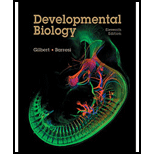
To review:
The need for the two different mechanism for the formation of neural tube in relation to the evolutionary pressures that forced the adoption of secondary neurulation. The idea which influence the timing of end of gastrulation and its capacity for axis elongation in relation to neurulation.
Introduction:
The set of morphogenetic events that leads to the formation of neural tube is known as neurulation. This process acts as a base for the formation of central nervous system in different organism. Neurulation is characterized as a complex set of cell movements which includes epithelial columnarization, migration, intercalation and convergent extension. Multiple genes are involvesd in regulation of this process. Neurulation is accompained by two modes, primary neurulation and secondary neurulation.
Explanation of Solution
The formation of vertebral neural tube into anterior and posterior tube are two independent processes specific in morphogenetic and molecular processes. The anterior tube forms by primary neurulation, in contrast posterior tube forms via secondary neurulation. The main difference between these two processes is the role of epithelial and mesenchymal cell population. Epithelial tissues are an organized and continuous sheet of cells associated by junctional complexes whereas the mesenchymal tissue are loosely connected cells.
The evolutionary studies indicate that the mechanism of primary neurulation was the ancestral condition and the secondary neuraltion is evolved later like the evolution of limbs. Before the formation of neural tube, primary neurulation uses a flat neural plat whereas the secondary neurulation starts with a mesenchymal cell population which later condensed. The comparision of early stages serve to evaluate the evolutionary conservation. The precise movement in different vertebrates, shows a number of solutions to the problem of change in neural plate cells into a neural tube. So the morphological and antamoical changes with due course of time may be a reason for the evolution of secondary neurulation. The neural induction, at any given time during gastrulation is regulated by the different cells at the organizer and under the control of precise gene regulation. The cell division in the neural plate is preferentially in anterior-posterior direction, which also regulates the axis elongation during gastrulation.
Thus it is concluded that primary neurulation was the ancestral condition and the secondary neuraltion is evolved later like the evolution of limbs. The comparision of early stages serve to evaluate the evolutionary conservation. The precise movement in different vertebra may be a reason for this evolutionary condition.
Want to see more full solutions like this?
Chapter 13 Solutions
Developmental Biology
- Need help 1 and 2 1.) Which of the following change occurs during the third trimester of fetal development? A. Skin appears bright pink due to blood-filled capillaries B. Lanugo hair develops C. Bone development begins D. All red bood cells are formed in the bone marrow 2.) Hormones play an important role in controlling the development and general metabolism of the human body Hormones are secreted by ductless glands called endocrine glandsFrom the following endocrine glands choose the one that develops from the ectoderm : A. Adrenal cortex B. Parathyroid gland C. Pituitary gland D. Thyroid glandarrow_forwardQuestion nursing. Oint When doctors discuss prenatal development, they often calculate the due date from the first day of menstruation. In fact, the baby’s gestational age is calculated from the first day of menstruation. At a maternity clinic, an obstetrician mentions that when a woman is 10 weeks pregnant, the baby is referred to as a fetus.Which of the following is the correct calculation of the baby’s age from the moment of fertilization, assuming a 28-day ovarian cycle? a. The baby is 8 weeks old. This is when organ formation has completed. b. The baby is 10 weeks old as stated by the doctor..arrow_forwardSubject [Developmental Biology] Question; In an OUTLINE FORM, describe briefly the phases of neurulation. Mention some signaling molecules, genes, morphogenetic factors, and other factors, intrinsic/extrinsic factors responsible for each phase. NOTE [Follow the instruction]arrow_forward
- TOPIC 2 OBJECTIVES • How do physical laws affect morphology? • What is meant by the term “efficiency”? • How can I make sure I’m using it correctly? • How does the size of an organism constrain its morphology? • How can we use physics to describe the function of vertebrate limbs? • How do vertebrates address the problems of movement through fluids? • How do we describe the strength of vertebrate tissues? • How do vertebrate tissues respond to stress? • How do physical constraints control the movement of materials between organisms and the environment?arrow_forwardQuestion:- There are specific critical periods during fetal development in which any damage caused to the fetus from malnutrition or exposure to toxins is irreversible. When do these periods occur? a) 3rd trimester b) 1st trimester c) 2nd trimester d) only at week 12 e) there are no critical periodsarrow_forward[questions 4-6] Volume of the sea Urchin egg is 5.2 x 105 µm3 . You fertilize the cells and take measurements of cellular dimensions at the four blastomere stage. Assume a perfect sphere 4) What is the radius of the sea urchin egg? A) 500 µm B) 100 µm C) 49.9 µm D) 25 mm E) 25 µm F) 6 metersarrow_forward
- please help 2 questions 1) how can you tell the difference between male and female fruit fly? 2) what mutation is sex linked?arrow_forwardQuestions for Part 2 for Ken Burns The Gene: An Intimate History "Revolution in the Treatment of Disease" What was the Human Genome Project? When was it and give results. What inherit dangers go along with genetic engineering? What is genome sequencing? What makes viruses unique for genetic engineering? What happened with the first Gene Therapy Trials for OTC at the University of Pennsylvania? Why did it fail specifically? Describe Sickle Cell Disease and on what gene does the mutation reside? Explain the significance of the companion gene and the gene for sickle cell in gene therapy? What is CRISPR and how is it used? please answer 4,5,6 please asap.arrow_forwardQuestions for Part 2 for Ken Burns The Gene: An Intimate History "Revolution in the Treatment of Disease" What was the Human Genome Project? When was it and give results. What inherit dangers go along with genetic engineering? What is genome sequencing? What makes viruses unique for genetic engineering? What happened with the first Gene Therapy Trials for OTC at the University of Pennsylvania? Why did it fail specifically? Describe Sickle Cell Disease and on what gene does the mutation reside? Explain the significance of the companion gene and the gene for sickle cell in gene therapy? What is CRISPR and how is it used? pleaae answer 1,2,3 asaparrow_forward
- Need help with question 1 and 2. 1.) Teratogens are agents that interfere with the normal growth of the fetus and induce abnormalities in them due to exposure during pregnancy. Teratogenic agents include various maternal health factors such as diabetes, physical agents such as ionizing agents, prescription drugs or over-the-counter medication, environmental chemicals such as mercury compounds, and many other recreational factors such as cigarettes and alcohol. Drugs and recreational factors such as cigarettes and alcohol are the main causes of fetal abnormalities. Many drugs cross the placenta by simple diffusion, and reach the fetus from the mother. The most common teratogenic effects of drugs are spontaneous abortions and congenital malformations. Some drugs, such as warfarin, phenytoin and thalidomide are known to have teratogenic effects. Thalidomide was a drug prescribed by doctors in the 1950s to reduce morning sickness, but after its deadly effects were recognized it was…arrow_forwardproposal project on Mesenchymal Stem/Stromal Cells for Rheumatoid Arthritis Treatmentarrow_forwardProject 2 Muscle Diseases: Muscular Dystrophy1Spunky is a 5-year-old girl who has very large calf muscles and shows severe weakness in her leg and armmuscles. Laboratory tests showed that Spunky has high levels of creatine phosphokinase in her urine. The doctor explained to her parents that Spunky!s muscles are being replaced by fat and connective tissue because her body cells cannot metabolize protein properly. As a result, Spunky!s cells cannot produce creatine from amino acids. Therefore, she cannot store creatine phosphate in her muscles that is necessary to provide energy for her muscles to contract. Help Spunky!s parents understand her disease by completing the following tasks.2. Write the origin and insertion point of each muscle.3. Draw a diagram to show how a muscle fiber uses energy for contraction.arrow_forward
 Understanding Nutrition (MindTap Course List)Health & NutritionISBN:9781337392693Author:Eleanor Noss Whitney, Sharon Rady RolfesPublisher:Cengage Learning
Understanding Nutrition (MindTap Course List)Health & NutritionISBN:9781337392693Author:Eleanor Noss Whitney, Sharon Rady RolfesPublisher:Cengage Learning Biology: The Dynamic Science (MindTap Course List)BiologyISBN:9781305389892Author:Peter J. Russell, Paul E. Hertz, Beverly McMillanPublisher:Cengage Learning
Biology: The Dynamic Science (MindTap Course List)BiologyISBN:9781305389892Author:Peter J. Russell, Paul E. Hertz, Beverly McMillanPublisher:Cengage Learning Anatomy & PhysiologyBiologyISBN:9781938168130Author:Kelly A. Young, James A. Wise, Peter DeSaix, Dean H. Kruse, Brandon Poe, Eddie Johnson, Jody E. Johnson, Oksana Korol, J. Gordon Betts, Mark WomblePublisher:OpenStax College
Anatomy & PhysiologyBiologyISBN:9781938168130Author:Kelly A. Young, James A. Wise, Peter DeSaix, Dean H. Kruse, Brandon Poe, Eddie Johnson, Jody E. Johnson, Oksana Korol, J. Gordon Betts, Mark WomblePublisher:OpenStax College



